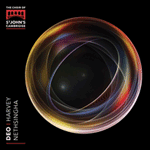In 1995 the Dean and Chapter commissioned the distinguished contemporary English composer Jonathan Harvey to compose a
Missa brevis. It is a striking and concentrated setting of the Ordinary of the Mass (that is, the invariable texts of the Communion service) that draws imaginatively on contemporary techniques and idioms, and yet is expressly intended to be sung liturgically. Harvey explains that the three main musical characteristics in the work can be taken to represent the glory of God (as in the opening section of the Gloria), the compassion of Jesus (the plaintive and insistent music of the Kyrie), and human suffering (parts of the Agnus Dei). A particularly interesting feature of the Gloria is Harvey’s use of shouted text alongside the sung parts. In the final, climactic section the choir seems to disintegrate into chaos as all the voices sing the music in their own time, like a babble of praise, coming together again only for the final phrase. The Sanctus begins with a still, low-set A major chord (perhaps inspired by some early Tudor Masses); at each repetition of the word ‘Sanctus’ Harvey progressively complicates the chord with added dissonant notes. The ‘Dominus Deus’ section builds up from a whisper of low voices to a striking, ringing A major ‘Hosanna’; like the opening ‘Sanctus’, this is immediately enriched with dissonant harmonies. An imposing and angular ‘Benedictus’ for solo bass follows, almost interrupted by the final ‘Hosanna’. The Agnus Dei expressively refers to music from the foregoing movements, thus drawing the Mass as a whole to a most satisfying close.
from notes by James O'Donnell © 2006
Voici une œuvre spécialement composée pour le chœur de l’abbaye de Westminster. En 1995, le doyen et le chapitre commandèrent une
Missa brevis à l’émérite compositeur anglais Jonathan Harvey. Il en résulta une mise en musique saisissante et concentrée de l’ordinaire de la messe (i.e. les textes immuables du service de la Communion) fondée, avec inventivité, sur des techniques et des idiomes contemporains, tout en demeurant expressément vouée à une exécution liturgique. Harvey voit dans les trois grandes caractéristiques musicales des l’œuvre le symbole de la gloire de Dieu (ainsi dans la section d’ouverture du Gloria), de la compassion de Jésus (la musique plaintive et insistante du Kyrie) et de la souffrance humaine (parties de l’Agnus Dei). Fait particulièrement intéressant, le Gloria donne à entendre un texte déclamé aux côtés des parties chantées. Dans la dernière section paroxystique, le chœur semble se désintégrer dans le chaos, toutes les voix chantant la musique chacune dans leur mesure, tel un babil de prières, avant de se rassembler pour la phrase finale. Le Sanctus commence par un accord en la majeur, paisible et grave (peut-être inspiré par quelque messe ancienne de l’ère Tudor); à chaque répétition du mot «Sanctus», Harvey complique un peu l’accord avec des notes dissonantes. Partant d’un murmure de voix graves, la section «Dominus Deus» enfle jusqu’à un saisissant et sonore «Hosanna» en la majeur; comme le «Sanctus» d’ouverture, cette section est immédiatement enrichie d’harmonies dissonantes. S’ensuit un «Benedictus», imposant et haché, pour basse solo, presque interrompu par l’«Hosanna» final. L’Agnus Dei renvoie avec expressivité à la musique des mouvements précédents, amenant ainsi la messe à une conclusion des plus convaincantes.
extrait des notes rédigées par James O'Donnell © 2006
Français: Hypérion
Es scheint angemessen, für dieses Fest des Heiligen Eduard ein Werk aufzunehem, das speziell für den Chor der Westminster Abbey komponiert wurde. 1995 gaben Dekan und Domkapitel bei dem renommierten zeitgenössischen englischen Komponisten Jonathan Harvey eine
Missa brevis in Auftrag. Es ist eine erstaunliche, konzentrierte Vertonung des Messordinariums (d. h. der unveränderlichen Texte des Kommunionsgottesdienstes), die sich einfallsreich auf zeitgenössische Techniken und Idiome bezieht, aber dennoch ausdrücklich zur liturgischen Aufführung gedacht ist. Harvey erklärt, dass die drei musikalischen Hauptmerkmale des Werkes als Repräsentation der Glorie Gottes (wie im Anfang des Gloria), des Erbarmens Jesu (die klagende und eindringliche Musik des Kyrie) und des menschlichen Leidens (Teile des Agnus Dei) verstanden werden kann. Ein besonders interessantes Merkmal im Gloria ist Harveys Gebrauch von gerufenem Text neben gesungenem. Am Ende kulminiert es in in einem Abschnitt, in dem der Chor in Chaos zu verfallen droht, als alle Stimmen wie in einer gemurmelten Lobpreisung in ihrem eigenen Tempo singen, und erst für die letzte Phrase wieder zusammenkommen. Das Sanctus beginnt mit einem ruhigen, tief gesetzten A-Dur-Akkord (womöglich von einigen Messen der frühen Tudorzeit angeregt); bei jeder Wiederholung des Wortes „Sanctus“ kompliziert Harvey den Akkord nach und nach durch zusätzliche dissonante Noten. Der Abschnitt „Dominus Deus“ eskaliert von einem Wispern tiefer Stimmen in ein erstaunliches, schallendes „Hosanna“; wie das einleitende „Sanctus“ wird auch dies sofort mit dissonanter Harmonik angereichert. Es folgt ein imposantes, kantiges „Benedictus“ für Solo-Bass, praktisch vom letzten „Hosanna“ unterbrochen. Das Agnus Dei bezieht sich ausdrucksvoll auf die Musik der vorhergehenden Sätze zurück und bringt daher die Messe insgesamt zu einem äußerst befriedigenden Abschluss.
aus dem Begleittext von James O'Donnell © 2006
Deutsch: Renate Wendel


 Harvey: Deo
Harvey: Deo
